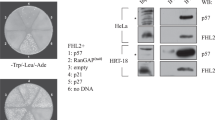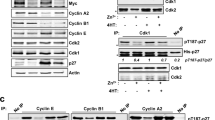Abstract
Loss of attachment to an extracellular matrix substrate arrests the growth of untransformed cells in the G1 phase. This anchorage-dependent cell cycle arrest is linked to increased expression of the p21Cip1 (p21) and p27Kip1 (p27) cyclin-dependent kinase inhibitors. The result is a loss of cdk2-associated kinase activity, especially that of cyclin E-cdk2. The levels of p21 and p27 are also upregulated in unattached transformed cells, but cyclin E-cdk2 activity remains high, and the cells are able to grow in an anchorage-independent manner. Increased expression of cyclin E and cdk2 appears to be partially responsible for the maintenance of cyclin E-cdk2 activity in transformed cells. To explore further the regulation of cyclin E-cdk2 in transformed cells, we have analysed the subcellular distribution of cyclin-cdk complexes and their inhibitors in normal human fibroblasts, their transformed counterparts, and in various human tumor cell lines. In substrate-attached normal fibroblasts, cyclin E and cdk2 were exclusively in the nuclear fraction, associated with one another. When normal fibroblasts were detached and held in suspension, cyclin E-cdk2 complexes remained nuclear, but were now found associated with the p21 and p27 cdk inhibitors and lacked histone H1 phosphorylating activity. In contrast, the transformed fibroblasts and tumor cells, which are anchorage-independent, had more than half of their cyclin E, cdk2, p21 and p27 in the cytoplasmic fraction, both in attached and suspended cultures. The cytoplasmic p21 and p27 were bound to cyclin E-cdk2, as well as to complexes containing cyclin A and cyclin D. The nuclear cyclin E-cdk2 complexes from the transformed cells grown in suspension contained only low levels of p21 and p27 and had histone H1 kinase activity. Thus, at least three mechanisms contribute to keeping cyclin E-cdk2 complexes active in suspended anchorage-independent cells: cyclin E and cdk2 are upregulated, as reported previously, cdk inhibitors are sequestered away from the nucleus by cytoplasmic cyclin-cdk complexes, and the binding of the inhibitors to nuclear cyclin E-cdk2 complexes is impaired.
This is a preview of subscription content, access via your institution
Access options
Subscribe to this journal
Receive 50 print issues and online access
$259.00 per year
only $5.18 per issue
Buy this article
- Purchase on Springer Link
- Instant access to full article PDF
Prices may be subject to local taxes which are calculated during checkout
Similar content being viewed by others
Author information
Authors and Affiliations
Rights and permissions
About this article
Cite this article
Orend, G., Hunter, T. & Ruoslahti, E. Cytoplasmic displacement of cyclin E-cdk2 inhibitors p21Cip1 and p27Kip1 in anchorage-independent cells. Oncogene 16, 2575–2583 (1998). https://doi.org/10.1038/sj.onc.1201791
Received:
Revised:
Accepted:
Published:
Issue Date:
DOI: https://doi.org/10.1038/sj.onc.1201791
Keywords
This article is cited by
-
Phosphorylated p27Kip1 on Thr157 is an important prognosis in human hepatocellular carcinoma in vivo and in vitro
Medical Oncology (2011)
-
Cellular thiol status-dependent inhibition of tumor cell growth via modulation of p27kip1 translocation and retinoblastoma protein phosphorylation by 1′-acetoxychavicol acetate
Amino Acids (2007)
-
A new hypothesis on the role of c-erbB2 oncogene in the progress of breast cancer
Bulletin of Experimental Biology and Medicine (2006)
-
Cytoplasmic p21 WAF1/CIP1 expression is correlated with HER-2/ neu in breast cancer and is an independent predictor of prognosis
Breast Cancer Research (2003)
-
Tenascin-C blocks cell-cycle progression of anchorage-dependent fibroblasts on fibronectin through inhibition of syndecan-4
Oncogene (2003)



